Fix Leggy Microgreen Stems Falling Over: Quick Guide

Are your microgreens looking limp and sad? You’re not alone. Many growers struggle with microgreen stems falling over. This guide will help you make your greens strong and healthy.
Microgreens are full of nutrients, up to nine times more than full-grown greens. But to grow them well, you need to balance a few key things. Lighting, watering, and more all play a big part in keeping your greens upright.
It doesn’t matter if you’re growing radish pink microgreens or pak choi. The basics are the same. Even if you’re using paper towels to grow them, knowing these basics is essential.
Key Takeaways
- Inadequate lighting is a primary cause of leggy microgreen growth
- Proper watering techniques are essential for stem strength
- Optimal seed spacing prevents overcrowding and weak stems
- Temperature control significantly impacts microgreen health
- Choosing the right growing medium supports robust stem development
- Regular monitoring and adjustments are key for successful microgreen cultivation
Understanding Leggy Microgreen Growth
Leggy microgreens can be a problem for indoor gardeners. These plants have long, thin stems and often lean. This affects their look and nutritional value. Let’s explore why microgreens become leggy and how to spot unhealthy growth.
What Causes Microgreens to Become Leggy
Not enough light is the main reason for leggy growth. Plants stretch towards light when it’s scarce. Overwatering and too many plants also cause this problem. Good grow lights help prevent this.
Signs of Unhealthy Stem Development
Look out for these signs of poor health in microgreens:
- Thin, weak stems that can’t hold the plant
- Pale or yellow leaves
- Slow growth
- Microgreens that fall over easily
Impact on Microgreen Quality
Leggy microgreens are not only ugly but also less nutritious. The energy spent on stem growth reduces leaf nutrients. Here’s what microgreens need to grow well:
| Microgreen Variety | Growth Period (Days) | Light Requirement (Hours/Day) | Ideal Temperature (°F) |
|---|---|---|---|
| Broccoli | 7-14 | 12-16 | 60-75 |
| Radish | 5-7 | 12-16 | 60-75 |
| Sunflower | 7-14 | 12-16 | 60-75 |
| Pea Shoots | 10-14 | 12-16 | 60-75 |
Knowing these factors helps prevent leggy growth. This way, your microgreens will be healthy, vibrant, and full of nutrients.
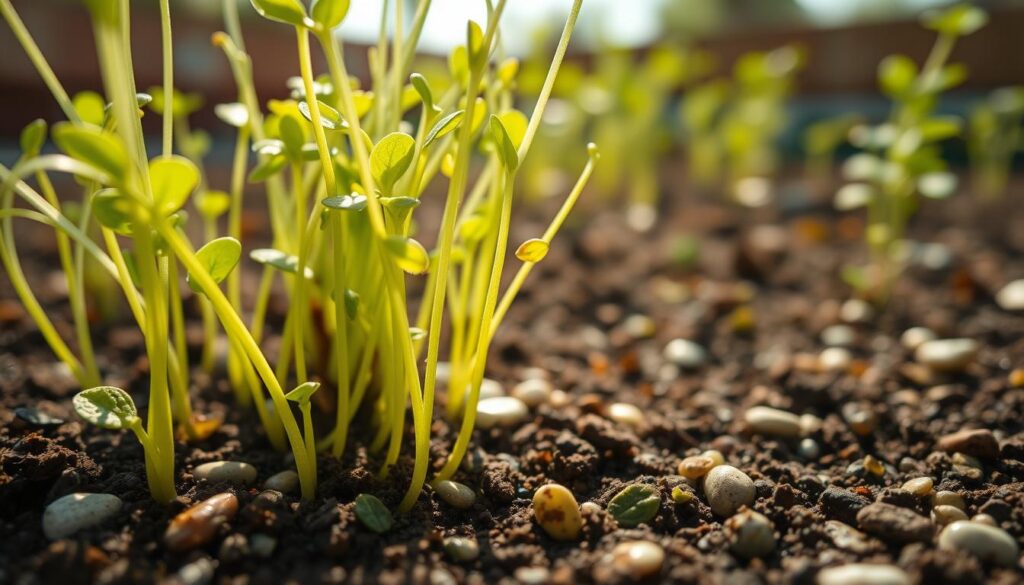
Light Requirements for Strong Stem Growth
Getting the right light is key to preventing leggy microgreens and making their stems strong. Knowing the best microgreen lighting solutions can greatly improve your growing results.
Natural vs Artificial Lighting Solutions
Natural sunlight is the best, but it’s not always possible. For those growing indoors, artificial light is a good choice. LED grow lights are top picks for growing microgreens. They save energy and let you adjust the light spectrum.
Optimal Light Positioning and Duration
Place your lights 15-30 cm above the microgreens for best growth. They need at least six hours of good light each day. Some growers use 12/12 or 18/6 light/dark cycles for better results.
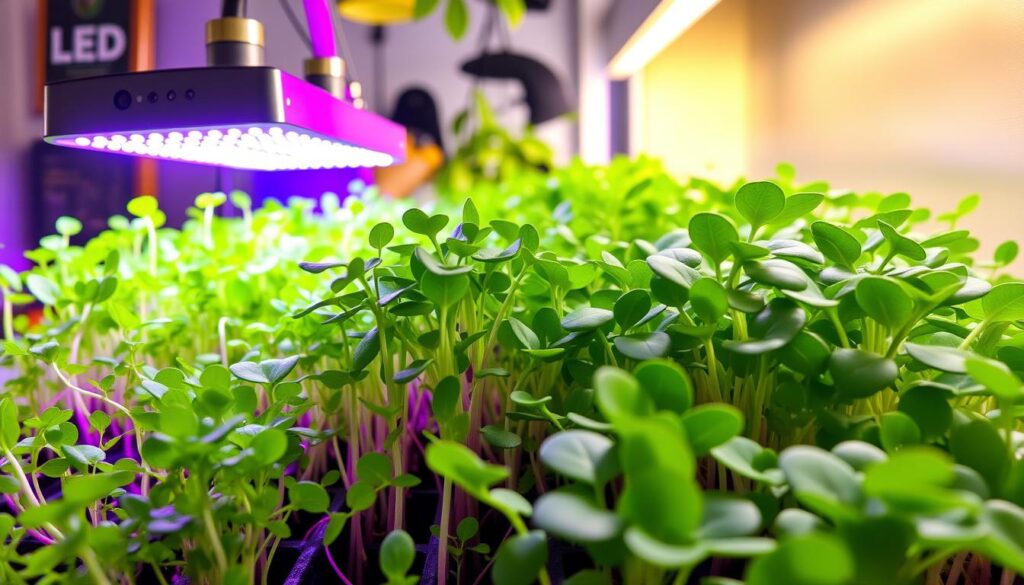
Managing Light Intensity for Different Varieties
Each microgreen type needs a different light level. For plants that take more than 20 days to grow, like herbs, use lights with a colour temperature over 4500K. This helps their stems grow strong and prevents them from becoming leggy.
“Providing bright light to seedlings immediately after germination is key to stop them from becoming leggy.”
By using these lighting tips, you’ll grow strong, healthy microgreens with sturdy stems.
Microgreen Stems Falling Over Leggy: Common Causes
When microgreen stems fall over, it’s a big problem. It can ruin the quality and amount of your microgreens. Knowing why it happens is key to fixing it.
Not enough light is a main reason for weak stems. Plants grow long and weak without enough light. Microgreens need several hours of light each day to grow well.
Watering wrong can also make stems fall over. Too much water can cause roots to rot, while too little makes them wilt. Finding the right water balance is important.
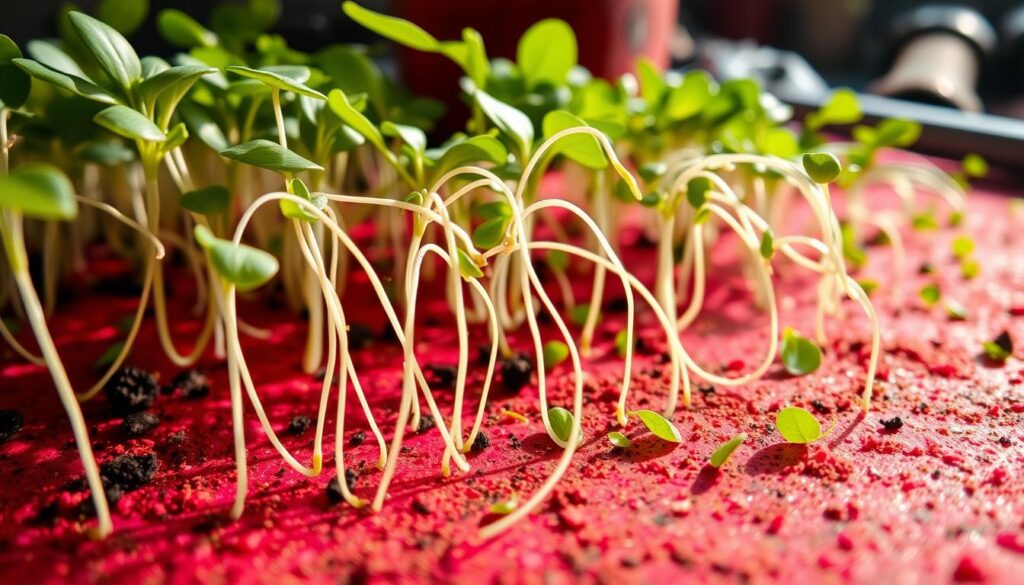
Long periods without light also weaken stems. While plants need darkness to start growing, too much darkness makes them stretch too much. Waiting too long to harvest is another issue. Microgreens should be picked when their first leaves are fully grown to avoid being too long.
| Cause | Effect | Solution |
|---|---|---|
| Insufficient light | Elongated, weak stems | Provide 12-16 hours of light daily |
| Overwatering | Damping off, root rot | Water 1-2 times daily, ensure proper drainage |
| Underwatering | Wilting, stunted growth | Maintain consistent moisture levels |
| Extended blackout | Excessive stretching | Limit blackout period to 2-3 days |
| Delayed harvesting | Leggy, weak plants | Harvest when cotyledons are fully developed |
By knowing these common problems, growers can fix them. This ensures their microgreens grow strong and healthy.
Proper Watering Techniques for Stem Strength
Learning how to water microgreens right is key to strong stems and healthy plants. The right amount of water helps stems grow strong and plants stay healthy.
Bottom Watering Methods
Bottom watering is a great way to make microgreen stems stronger. You need two containers: one for planting and another for water. Put the planting tray in the water, letting the soil soak up moisture from below.

Moisture Level Management
Keeping the right moisture level is important to stop growth problems. Check the soil every day and water when it’s dry. For best results, keep the air around your plants less than 70% humid.
Some herbs, like basil and parsley, need a daily mist in dry winter months. Mediterranean herbs, such as rosemary and thyme, do well with misting twice a week.
Avoiding Overwatering Issues
Too much water can cause mould and weak stems, making microgreens fall over. To prevent this, make sure your trays drain well and use a growing medium that drains well too. A mix of peat moss and perlite helps with air and water flow, cutting down on mould.
Keep your containers 2-3 inches apart for air to move freely. This helps stop fungal growth in your indoor herb garden.
| Watering Technique | Benefits | Frequency |
|---|---|---|
| Bottom Watering | Strengthens roots, prevents leaf damage | Every 1-2 days |
| Misting | Maintains humidity, suitable for delicate seedlings | 1-2 times daily |
| Drip Irrigation | Consistent moisture, reduces water waste | As needed, based on soil moisture |
Temperature Control for Optimal Growth
Getting the temperature right for microgreens is key to stopping them from growing too long and weak. Most microgreens grow best at around 21°C (70°F).
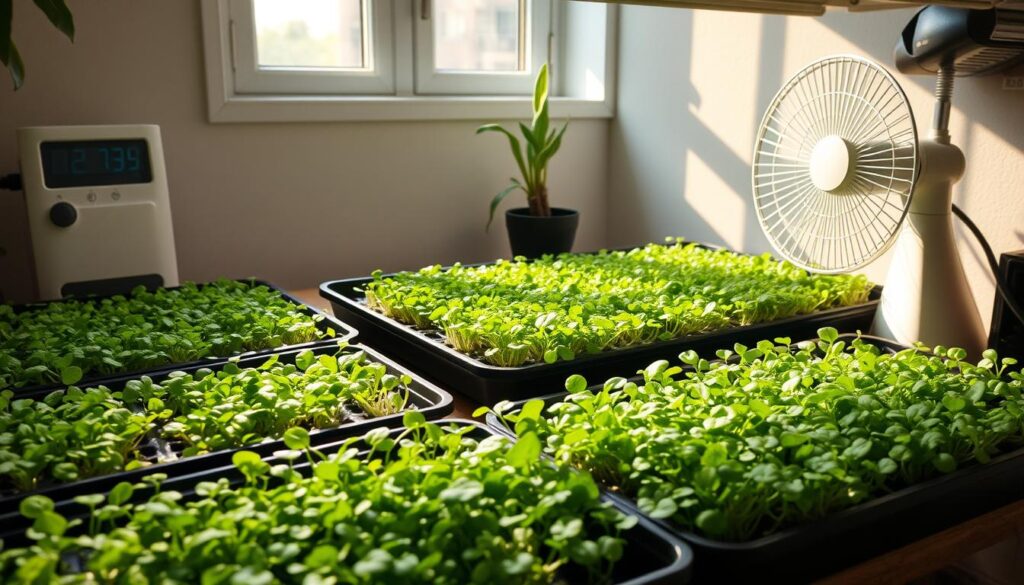
Keeping the temperature steady is important for strong growth. Don’t let it get too cold or too hot. Seeds need different temperatures to grow well, so check what each one needs.
Once they start growing, a bit cooler can stop them from getting too tall too fast. This is a key part of growing microgreens that new growers often miss.
| Growth Stage | Ideal Temperature Range |
|---|---|
| Germination | 21°C – 24°C (70°F – 75°F) |
| Seedling | 18°C – 21°C (65°F – 70°F) |
| Mature Microgreens | 15°C – 18°C (60°F – 65°F) |
For better temperature control, use seedling heat mats in cold places. They help keep the temperature steady and ensure even growth in your trays.
But temperature control is just part of the job. You also need the right light, water, and air for healthy, green microgreens.
Seed Spacing and Density Management
Getting the right seed spacing is vital for dense microgreen growth. It stops overcrowding and helps all plants grow evenly. This ensures your microgreens do well. Let’s look at some top microgreen seeding techniques and how to stop overcrowding.
Optimal Seeding Rates
Finding the perfect seed density is essential. You want a full crop but not too many seeds. This stops plants from fighting for food and growing too long. Different types of microgreens need different amounts of seeds.
For example, tiny seeds like cress or arugula need more seeds than bigger ones like sunflower or pea shoots.
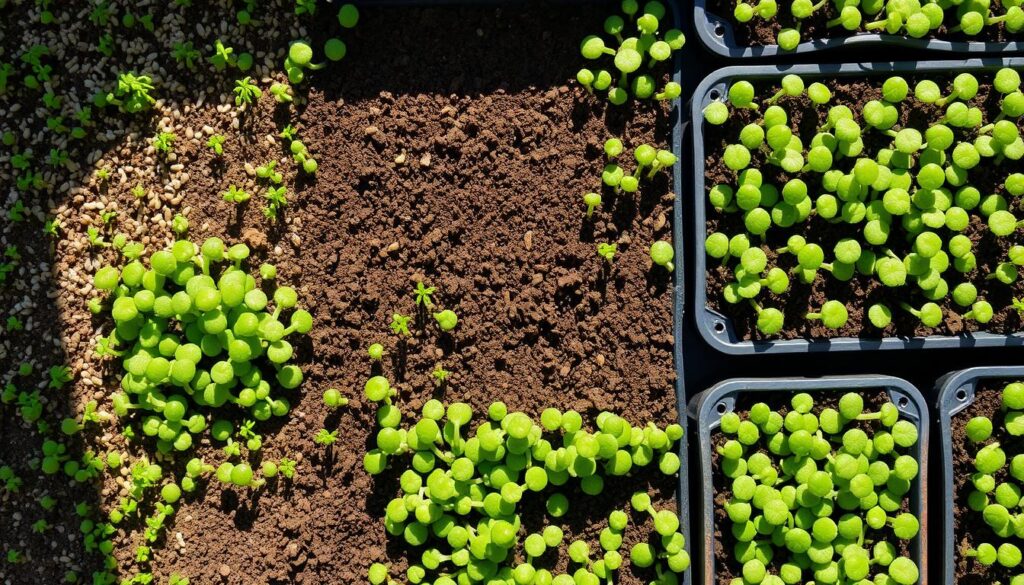
Prevention of Overcrowding
To stop overcrowding, try these tips:
- Use seed shakers or mix seeds with sand for even distribution
- Sow seeds when they will swell and absorb moisture quickly during certain moon phases
- Maintain proper spacing to ensure adequate air circulation and light penetration
- Avoid sowing too densely, which can lead to rotting before harvest
Also, choosing the right growing medium is key for preventing overcrowding and healthy growth.
Proper Thinning Techniques
If you’ve overseeded, don’t panic. Thinning seedlings quickly can fix it. Leave 1-2 plants per cell, removing the weakest ones. This lets the stronger plants grow better and healthier.
| Microgreen Type | Optimal Seeding Density (grams/10×20 tray) | Growth Period (days) |
|---|---|---|
| Radish | 30-35 | 7-10 |
| Broccoli | 25-30 | 10-14 |
| Sunflower | 100-120 | 8-12 |
| Pea Shoots | 150-180 | 10-14 |
By learning these methods, you’ll grow healthy, vibrant microgreens. Always sow in small batches to keep a steady supply all year.
Air Circulation and Ventilation Strategies
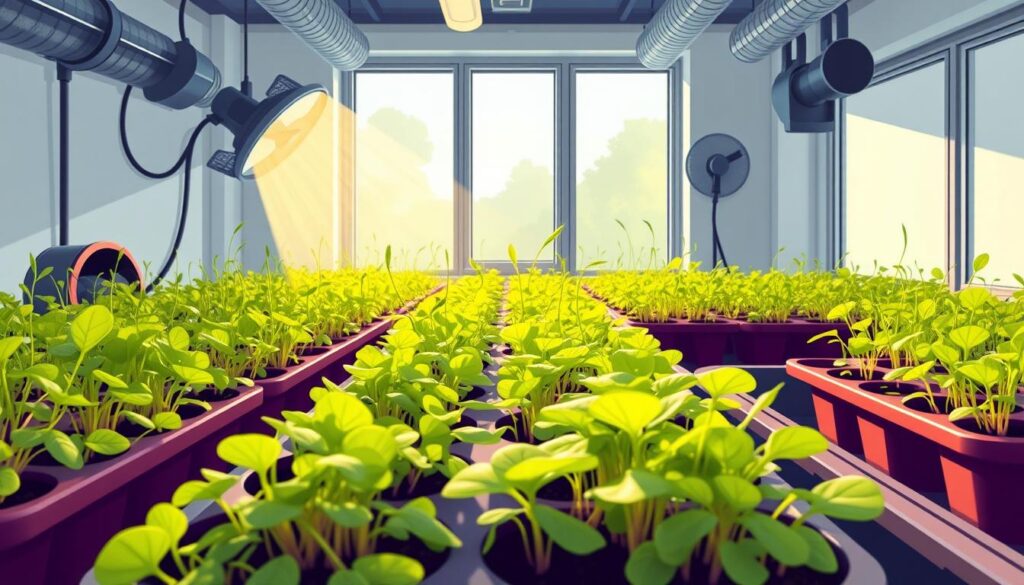
Good air flow is key for healthy microgreens. It stops mould and helps plants grow strong. Let’s look at ways to keep the air moving well in your microgreen area.
Using small fans can help a lot. They make a soft breeze that’s good for your plants. Also, keep trays apart to let air move freely and stop diseases.
Here’s a quick guide to keeping air moving:
- Position fans to make a gentle breeze
- Keep 2-3 inches of space between trays
- Watch humidity, aiming for 50-60%
- Open windows or use a dehumidifier if it’s too humid
Finding the right air flow is tricky. Too much can dry out your greens, while too little can cause mould. You want a breeze that’s soft but steady.
Good air flow does more than stop mould. It also makes stems stronger. This is similar to how growing basil indoors needs the right air flow for best results.
| Ventilation Method | Benefits | Considerations |
|---|---|---|
| Small fans | Improved air circulation, stronger stems | Avoid direct airflow on seedlings |
| Proper tray spacing | Better air flow, reduced disease risk | Requires more growing space |
| Natural ventilation | Cost-effective, mimics outdoor conditions | Weather-dependent, less control |
By using these methods, you’ll help your microgreens grow strong and healthy. This also cuts down on mould and other problems from bad air flow.
Growing Medium Selection and Preparation
Choosing the right growing medium is key for healthy microgreen stems. A mix that drains well provides nutrients and support for growth. Let’s look at the best options and how to prepare them for your microgreens.
Best Soil Types for Strong Stems
For the best results, pick a high-quality potting mix made for container gardening. These mixes drain well and breathe, helping roots grow strong. Don’t use garden soil, as it can have pests or diseases that harm your microgreens.

Medium Depth Requirements
The medium’s depth is important for your microgreens. Aim for 1-2 inches deep, depending on the type. This depth gives roots enough room without letting waterlog the soil.
Soil Preparation Techniques
Getting your soil right is vital for growing microgreens. Begin by moistening the medium evenly before planting seeds. This creates a perfect start for germination and growth. Make sure the soil is even and slightly compacted for a stable base.
| Soil Preparation Step | Purpose |
|---|---|
| Moistening the medium | Promotes even germination |
| Levelling the surface | Ensures uniform growth |
| Light compaction | Provides stability for roots |
By following these tips for growing medium selection and preparation, you’ll set up your microgreens for success. The right mix and preparation are critical for growing healthy microgreen stems.
Conclusion
Learning microgreen cultivation tips is key for a great harvest. Solving problems like leggy stems and uneven growth leads to healthy microgreens. Success in growing microgreens in India depends on light, water, and temperature.
Starting with common Indian varieties like fenugreek, mustard, and coriander is simple. These fast-growing greens, including radish and mung bean, are ready in 7-9 days. To avoid leggy microgreens, keep seeds apart and care for them consistently.
Whether for personal use or a business, microgreens are a great choice. They need little space and can be grown all year. By following these tips and staying alert, you’ll grow vibrant, nutritious microgreens. They’ll make your cooking and business better.






